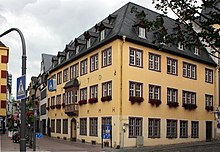Dreikönigenhaus (Koblenz)
The Dreikönigenhaus is a baroque building in the old town of Koblenz . The Adelshof, built in 1701, was named after the Three Kings .
history
Before the construction, there was a garden on the site , which in a protocol from 1538 was called the Holy Three Kings Altar Garden . In 1595 there was a town house that was sold and later the inn for the three kings moved into it. This building was probably destroyed in the devastating bombardment during the siege of the city of Koblenz by French troops in the Palatinate War of Succession in 1688 .
The current building was built in 1701. The building owner was the councilor Johann Wilhelm Hauschild, in the literature the architect of the Electorate of Trier, Johann Christoph Sebastiani , who had completed the Jesuit college shortly before, is named as the architect . Hauschild leased the newly built house soon after. The von Breidbach zu Bürresheim family was one of the new tenants . The Archbishop of Mainz Emmerich Joseph von Breidbach zu Bürresheim (1707–1774) was born in the building.
The house was bought in 1711 by the Trier cathedral dean Anton Freiherr zu Eltz zu Rübenach , who demanded "noble immunity " for the building, which is now called Eltz-Rübenacher Hof, i.e. the exemption from real and personal charges. After his death, the building passed to Damian Lothar von Eltz-Rübenach , who had the Carmelite monastery rebuilt in Boppard in 1730 . His son, the electorate councilor Franz Ludwig von Eltz-Rübenach , expanded the Three Kings House in 1779 to include an extension for servants and economic purposes. The basalt plaque with the building inscription is still on the front of the courtyard today.
During the French occupation (1794-1814) the post office was housed in the Epiphany . During this time, the French Marshal Michel Ney took his quarters in the building. The Eltz-Rübenach family sold it in 1817 for 30,500 francs to the merchants Philipp Pfender and Georg Bernhard Sehmer.
During the Second World War , the Dreikönigenhaus was badly damaged by explosive bombs in the air raids on Koblenz . A provisional reconstruction took place as early as 1948. After the final reconstruction and restoration between 1976 and 1977, the Koblenz City Library moved into the building. The reconstruction restored the outer form true to the original, inside the wooden staircase was reconstructed in its old form (but as a fire-proof concrete structure with wooden cladding). Since all the ceilings had to be renewed, remnants of the stucco ceilings that had been preserved were finally lost.
After the Forum Confluentes was completed in 2013, the city library, which was spread over several buildings, moved into the new cultural building on the central square . In the same year the city of Koblenz sold the Dreikönigenhaus together with the old department store , the Bürresheimer Hof and the Schöffenhaus to a private investor (ISSOflorinsmarkt GmbH & Co. KG), who wants to renovate the building and then accommodate an institute close to the university. The renovation work on the Dreikönigenhaus began in autumn 2014, and the renovated building was reopened in November 2015.
construction
The three-storey, two-wing baroque building has a hipped roof with dormers . On the simple plastered facade, iron anchors show the year 1701 and the initials WH and MMH (H probably stands for the builder Hauschild). A rectangular bay with a three-part relief depiction protrudes above the entrance . In the relief, which is one of the last examples of such oriel reliefs to be preserved in the residential construction of Koblenz in the 17th and 18th centuries, depicts the Adoration of the Magi ( Mt 2.11 EU ). The original entrance door and the baroque one are preserved Stair gate in the stairwell. The building has a basement partially, originally probably for the storage of beer barrels, since the builder was a brewer by profession. In the quarry stone vaulted cellar there is a deep brick well. Since the last restoration, the building has had a new, white and gray color scheme.
Monument protection
The Dreikönigenhaus is a protected cultural monument under the Monument Protection Act (DSchG) and entered in the list of monuments of the state of Rhineland-Palatinate . It is located in the old town monument zone .
The Dreikönigenhaus has been part of the Upper Middle Rhine Valley UNESCO World Heritage Site since 2002 . Furthermore, it is a protected cultural asset according to the Hague Convention and marked with the blue and white protection symbol.
literature
- Energieversorgung Mittelrhein GmbH (ed.): History of the city of Koblenz . Overall editing: Ingrid Bátori in conjunction with Dieter Kerber and Hans Josef Schmidt
- Vol. 1: From the beginning to the end of the electoral era . Theiss, Stuttgart 1992. ISBN 3-8062-0876-X
- Vol. 2: From the French city to the present . Theiss, Stuttgart 1993. ISBN 3-8062-1036-5
- Fritz Michel : The art monuments of the city of Koblenz. The profane monuments and the suburbs , Munich Berlin 1954, pp. 176–180 (The art monuments of Rhineland-Palatinate first volume).
- Cultural monuments in Rhineland-Palatinate Volume 3.2. City of Koblenz. City center , edited by Herbert Dellwing and Reinhard Kallenbach , Speyer 2004, p. 164. ISBN 3-88462-198-X
- City of Koblenz: Koblenz historic old town: Dreikönigenhaus, Haus Metternich. Documentation on the reconstruction after the partial destruction in the war in 1944, Koblenz 1977
Web links
- Eltz-Rübenacher Hof / Dreikönigenhaus in: regionalgeschichte.net
Individual evidence
- ^ Georg Dehio: Handbook of German Art Monuments . Rhineland-Palatinate, Saarland. Deutscher Kunstverlag, Munich 1985 (2nd edition)
- ↑ Florinsmarkt: Görlitz buys the historic buildings from the city in: Rhein-Zeitung , September 30, 2013
- ↑ http://www.issolab.de
- ↑ General Directorate for Cultural Heritage Rhineland-Palatinate (ed.): Informational directory of cultural monuments - District-free city of Koblenz (PDF; 1.3 MB), Koblenz 2011
Coordinates: 50 ° 21 ′ 41.8 " N , 7 ° 35 ′ 52.8" E


